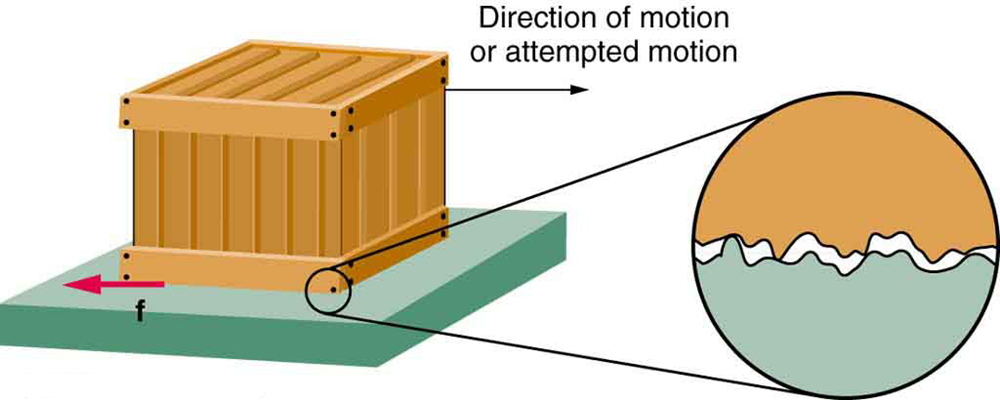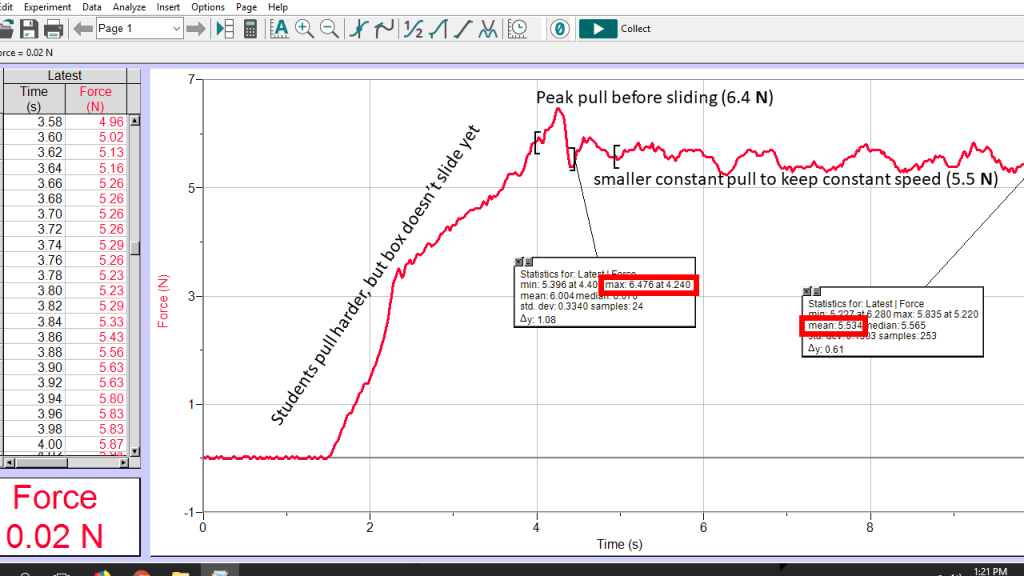40 Slipping
Slipping
Slipping happens when friction between feet and walking surface is not large enough to prevent your back foot from sliding as it pushes off, or the front foot from sliding when it tries to slow the forward motion of your center of gravity). Together, normal force and friction (![]() ) provide the forces necessary to support the body and maintain balance. For example, friction prevents crutches from sliding outward when they aren’t held perfectly vertical. Friction is also necessary for locomotion, such as walking and running, as we will learn in the Locomotion unit.
) provide the forces necessary to support the body and maintain balance. For example, friction prevents crutches from sliding outward when they aren’t held perfectly vertical. Friction is also necessary for locomotion, such as walking and running, as we will learn in the Locomotion unit.

Friction
Friction (![]() ) is the force that resists surfaces sliding against one another. Rub your palms together, the resistance you feel is friction. Complimentary to normal force, which only points perpendicular to surfaces, friction only points parallel to surfaces. Two surfaces must touch to have friction, so you also can’t get friction without normal force. In fact, frictional force is proportional to normal force.
) is the force that resists surfaces sliding against one another. Rub your palms together, the resistance you feel is friction. Complimentary to normal force, which only points perpendicular to surfaces, friction only points parallel to surfaces. Two surfaces must touch to have friction, so you also can’t get friction without normal force. In fact, frictional force is proportional to normal force.
Reinforcement Activity
Rub your palms together. Now push your palms together hard and try to slide them at the same time.
Now the normal force is larger causing the frictional force to grow in proportion.

Kinetic Friction
Kinetic friction (![]() ) acts whenever two surfaces are sliding past one another and typically the size of the kinetic friction does not depend on the relative speed between the sliding surfaces. If an object is sliding, but there not another force pushing the object to keep it sliding, then kinetic friction will eventually stop the sliding object. (Give an object a shove so that it slides across the floor and it will eventually stop. That is kinetic friction at work).
) acts whenever two surfaces are sliding past one another and typically the size of the kinetic friction does not depend on the relative speed between the sliding surfaces. If an object is sliding, but there not another force pushing the object to keep it sliding, then kinetic friction will eventually stop the sliding object. (Give an object a shove so that it slides across the floor and it will eventually stop. That is kinetic friction at work).
Static Friction
Unlike kinetic friction, static friction does not have a constant value. Instead, static friction adjusts to prevent the surfaces from slipping, but it can only do so up to a maximum value. If the force required to prevent slipping is larger than the maximum static friction value, the object will slide and kinetic friction takes over. Static friction is larger than kinetic friction. The following graph of force vs. time demonstrates the process of “breaking free” of static friction between two surfaces. The graph was created by measuring the force that students applied to a box sitting on a table by pulling on a string tied to the box.

Choose the friction simulation from the simulation set to see how static and kinetic friction behave.
Reinforcement Activity
Friction Coefficient
We now know that friction force is proportional to normal force and that there are two types of friction, static and kinetic. The final concept that affects friction is the roughness, or alternatively the smoothness, of the two surfaces. The coefficient of friction (![]() ) is a unitless number that rates the roughness and is typically determined experimentally. The static frictional force is larger than the kinetic frictional forces because
) is a unitless number that rates the roughness and is typically determined experimentally. The static frictional force is larger than the kinetic frictional forces because ![]() is larger than
is larger than ![]() . Take a look at the table of static and kinetic friction coefficients found below. You can find more values in this massive table of static friction coefficients.
. Take a look at the table of static and kinetic friction coefficients found below. You can find more values in this massive table of static friction coefficients.
| Rubber on dry concrete | 1.0 | 0.7 |
|---|---|---|
| Rubber on wet concrete | 0.7 | 0.5 |
| Wood on wood | 0.5 | 0.3 |
| Waxed wood on wet snow | 0.14 | 0.1 |
| Metal on wood | 0.5 | 0.3 |
| Steel on steel (dry) | 0.6 | 0.3 |
| Steel on steel (oiled) | 0.05 | 0.03 |
| Teflon on steel | 0.04 | 0.04 |
| Bone lubricated by synovial fluid | 0.016 | 0.015 |
| Shoes on wood | 0.9 | 0.7 |
| Shoes on ice | 0.1 | 0.05 |
| Ice on ice | 0.1 | 0.03 |
| Steel on ice | 0.4 | 0.02 |
Notice that two surfaces are always listed in the table; you must have two surfaces to define a ![]() . When someone asks a question like, “what is the
. When someone asks a question like, “what is the ![]() of ice?” they usually mean between ice and ice, but its best to avoid asking such questions and just always reference two surfaces.
of ice?” they usually mean between ice and ice, but its best to avoid asking such questions and just always reference two surfaces.
Calculating Friction Forces
We can sum up everything we have learned about friction in two equations that relate the friction forces to the friction coefficient for two surfaces and the normal force acting on the surfaces:
Max static friction before release:
(1) ![]()
Kinetic friction once moving:
(2) ![]()
Everyday Example: Firefighter Physical Ability Test
Firefighter candidates must complete a physical ability test (PAT) that includes dragging a dummy across the floor. The PAT for the city of Lincoln Nebraska specifies that candidates must drag a human form dummy weighing 170 lbs for 25 feet, around a barrel, and then back across the starting point for a total distance of 50 feet in six minutes or less. The candidates may only drag the dummy using the pull harness attached to the dummy and cannot carry the dummy[5].
The test is held on a polished concrete floor. The static friction coefficient between cotton clothing and polished concrete is 0.5. If a candidate pulls vertically up on the harness with a force of 70 lbs what horizontal pull force must the candidate apply in order to get the dummy moving?
The dummy starts out in static equilibrium so we know the net force must be zero in both the veritical and horizontal directions. First, let’s analyze the vertical direction: if the candidate pulls vertically up on the harness with a force of 70 lbs then the floor must provide a normal force of 100 lbs to support the dummy.
Now let’s analyze the horizontal direction: static friction will match whatever horizontal pull the candidate provides, but in the opposite direction, so that the dummy stays in static equilibrium until the pull exceeds the max static friction force. That’s the force the candidate needs to apply to get the dummy moving, so let’s find that. We have the friction coefficient and we already found the normal force so we are ready:
![]()
After the dummy starts moving, kinetic friction kicks in so we can use ![]() to calculate the kinetic frictional force. The is force is less than the max static frictional force, so it will require less force to keep the dummy moving than it did to get it started.
to calculate the kinetic frictional force. The is force is less than the max static frictional force, so it will require less force to keep the dummy moving than it did to get it started.
![]()
Reinforcement Exercises

The equations given for static and kinetic friction are empirical models that describe the behavior of the forces of friction. While these formulas are very useful for practical purposes, they do not have the status of laws or principles. In fact, there are cases for which these equations are not even good approximations. For instance, neither formula is accurate for surfaces that are well lubricated or sliding at high speeds. Unless specified, we will not be concerned with these exceptions.[6]
- "Photo" by Fritz Henle, Library of Congress is in the Public Domain ↵
- "History of Salk" by The Salk Institute ↵
- "What is Polio" by Global Heatlh, Center for Disease Control ↵
- OpenStax University Physics, University Physics Volume 1. OpenStax CNX. Aug 2, 2018 http://cnx.org/contents/d50f6e32-0fda-46ef-a362-9bd36ca7c97d@11.1. ↵
- "Firefighter Physical Ability Test Candidate Orientation Guide" by Industrial/Organizational Solutions, Inc. ↵
- OpenStax University Physics, University Physics Volume 1. OpenStax CNX. Aug 2, 2018 http://cnx.org/contents/d50f6e32-0fda-46ef-a362-9bd36ca7c97d@11.1. ↵
a force that acts on surfaces in opposition to sliding motion between the surfaces
a point at which the force of gravity on body or system (weight) may be considered to act. In uniform gravity it is the same as the center of mass.
the outward force supplied by an object in response to being compressed from opposite directions, typically in reference to solid objects.
movement or the ability to move from one place to another
at an angle of 90° to a given line, plane, or surface
side by side, pointing in exactly the same direction, or having the same distance continuously between them
having a constant ratio to another quantity
a force that resists the sliding motion between two surfaces
a force that resists the tenancy of surfaces to slide across one another due to a force(s) being applied to one or both of the surfaces
coefficient describing the combined roughness of two surfaces and serving as the proportionality constant between friction force and normal force
the state being in equilibrium (no unbalanced forces or torques) and also having no motion
mathematical explanation of the relation between measured values that is used for making predictions
a statement, usually in the form of a mathematical equation, that summarizes, but not explains, the results of repeated experiments or observations that describe some aspect of the natural, usually within a certain range of application.
principles summarize rules created and followed by scientists when formulating hypotheses, designing experiments, analyzing results.
a rough value obtained without making a measurement by using prior knowledge and assumptions.

